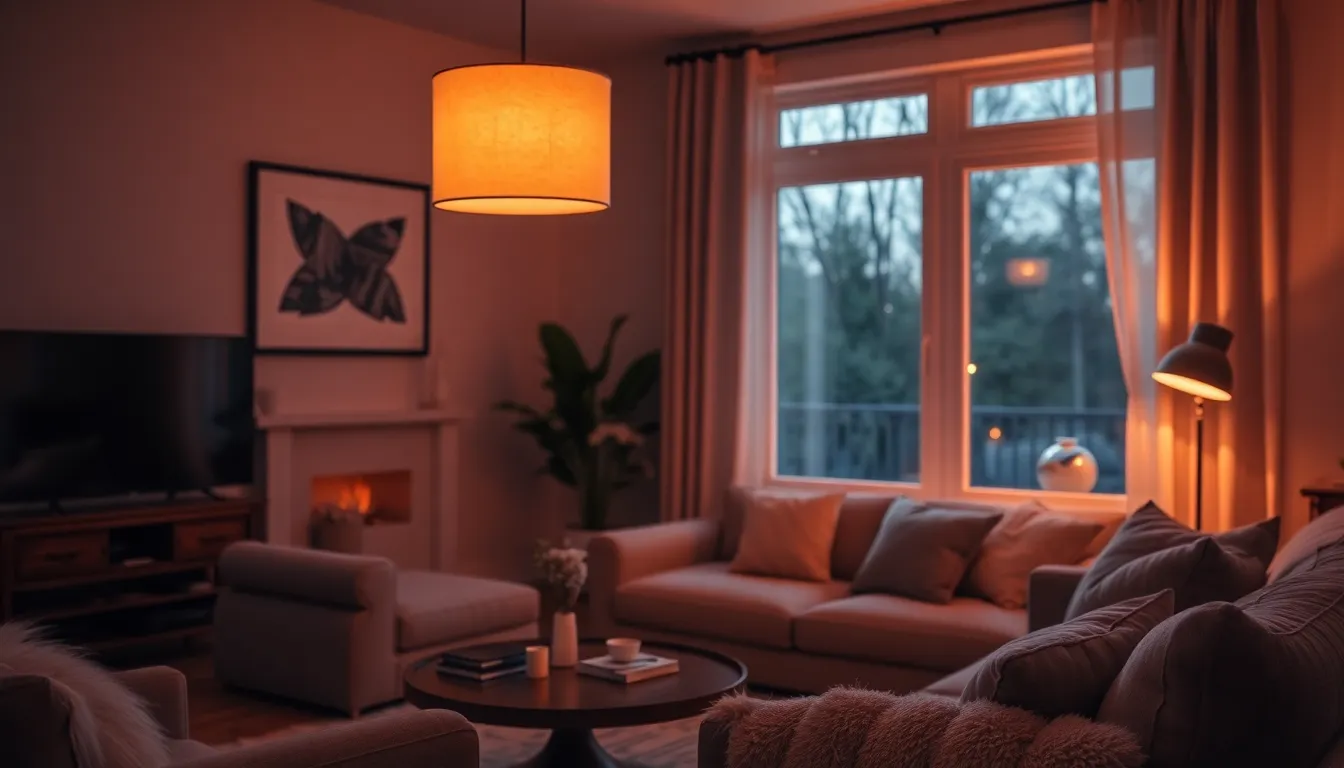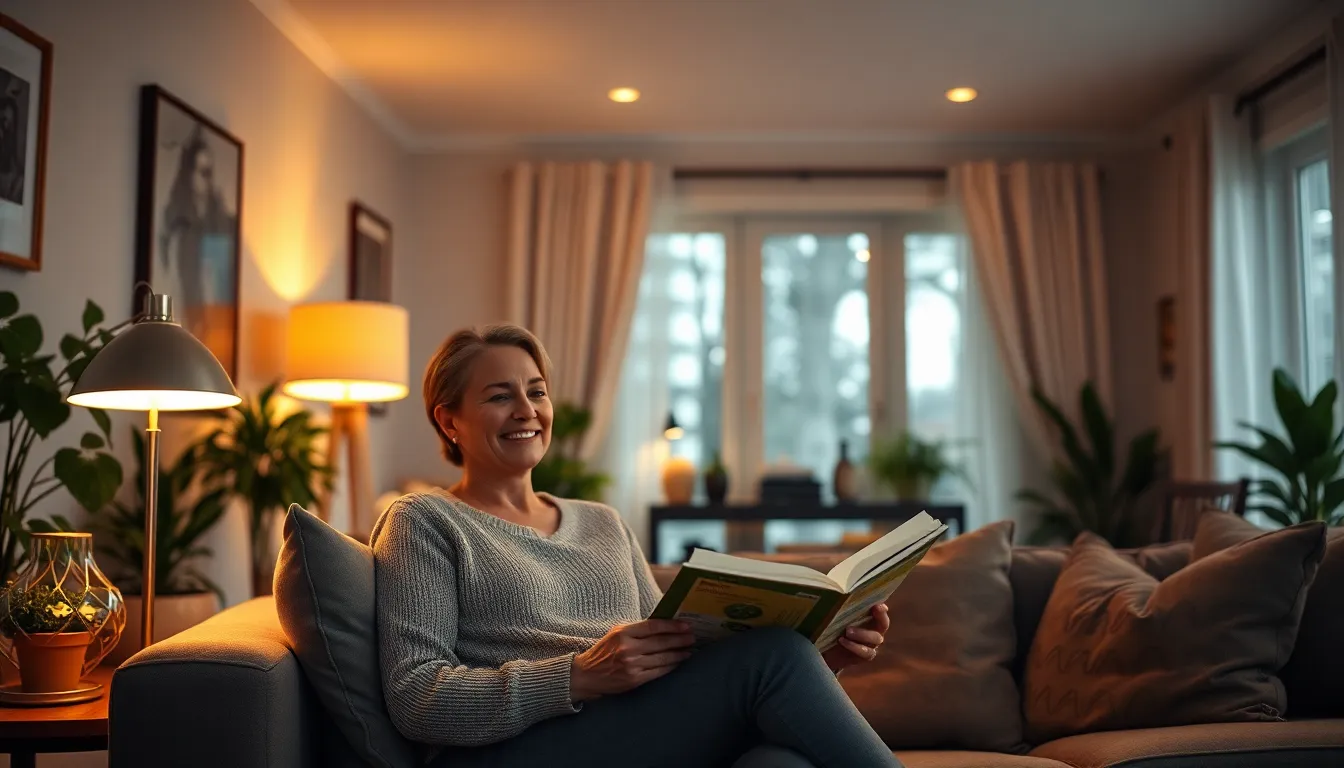Imagine walking into a room where the lighting whispers sweet nothings to your senses. Mood lighting isn’t just about flicking a switch; it’s about creating an atmosphere that can turn an ordinary evening into a magical experience. Whether it’s a cozy dinner date or a solo Netflix binge, the right lighting sets the stage for unforgettable moments.
But let’s face it—most people don’t think about lighting until they’re squinting at their phone in a dimly lit restaurant. With the right mood lighting, you can elevate your space from drab to fab, making even the most mundane tasks feel like a scene from a rom-com. So grab your favorite dimmer switch and get ready to bask in the glow of ambiance that’ll have your friends wondering if you’ve hired a professional lighting designer.
Table of Contents
ToggleWhat Is Mood Lighting?
Mood lighting refers to the use of light to create a particular atmosphere or emotion in a space. This type of lighting enhances the aesthetic appeal and influences people’s feelings and behaviors. Soft, warm lights often evoke a sense of comfort, making them ideal for relaxation areas like living rooms or bedrooms. In contrast, bright, cooler lights can energize and stimulate, suitable for workspaces or kitchens.
Different types of fixtures contribute to mood lighting. Table lamps, floor lamps, and dimmable ceiling lights provide versatility and control. His use of colored bulbs or LED strips adds a unique flair, allowing for personalization based on preferences or occasions. Varying intensities can change the dynamic of a room, shifting the mood at different times of day.
Positioning also plays a crucial role in defining mood lighting. Placing lights near reflective surfaces enhances their effects, creating pleasant patterns and shadows. Layering light sources—such as combining ambient, task, and accent lights—optimizes the overall aesthetic. This approach allows individuals to find just the right combination for any event.
Scientific research supports the idea that lighting affects mood and productivity. Studies show that appropriate lighting can significantly improve focus and well-being. People often gravitate toward spaces with inviting atmospheres, which encourages thoughtful designs using mood lighting. By strategically utilizing this concept, anyone can transform common experiences into memorable occasions.
Benefits of Mood Lighting

Mood lighting offers various advantages that significantly enhance the environment. It transforms spaces, setting the perfect tone for multiple occasions.
Enhancing Atmosphere
Creating an inviting atmosphere hinges on the right lighting choices. Soft light from lamps and dimmable fixtures fosters warmth and intimacy in living rooms and dining areas. Bright lighting may invigorate study spaces or home offices, encouraging productivity. Utilizing colored bulbs provides opportunities for personalization, further augmenting ambiance. Positioning lights strategically around reflective surfaces improves the overall aesthetic experience. Layering distinct light sources adds depth, enriching the visual appeal of any room.
Improving Well-Being
Mood lighting positively impacts well-being by influencing emotions and behaviors. Research indicates that warm light can reduce stress and promote relaxation in spaces such as bedrooms and lounges. Controlling light intensity helps create a serene environment conducive to unwinding. Additionally, bright cooler lights enhance focus during work hours, boosting motivation. Incorporating mood lighting into daily routines can lead to improved mental health and overall happiness. Individuals experience better sleep quality when using appropriate lighting techniques.
Types of Mood Lighting
Mood lighting types significantly contribute to creating the desired atmosphere. These forms of lighting serve specific purposes and enhance experiences in various settings.
Ambient Lighting
Ambient lighting provides general illumination for a space. Soft lighting creates a cozy and inviting environment, ideal for relaxation. Typical sources include ceiling fixtures, floor lamps, and wall sconces. A well-designed ambient light layer ensures even distribution of light, eliminating shadows. Using warm white bulbs enhances the comfort and tranquility of living areas, making them feel more welcoming. This type of lighting forms the foundation for effective mood setting.
Task Lighting
Task lighting focuses on specific activities that require brighter illumination. It helps individuals concentrate during tasks like reading, studying, or cooking. Versatile fixtures such as desk lamps and under-cabinet lights effectively enhance visibility. Targeted light helps minimize eye strain and improves productivity. Bright daylight bulbs often work best in workspaces, while softer options suit reading areas. Integrating this type of lighting ensures functionality and enhances the overall environment.
Accent Lighting
Accent lighting adds depth and interest to a space by highlighting specific features or décor. This creates focal points that draw attention to artwork, plants, or architectural details. Types of accent lighting include directional spotlights, track lighting, and wall-mounted fixtures. Colored bulbs or adjustable fixtures can infuse personality and excitement into the design. Incorporating accent lighting not only transforms the look of a room but also enriches the overall ambiance, making it more visually appealing.
Best Practices for Using Mood Lighting
Implementing mood lighting effectively maximizes its benefits. Thoughtful consideration of color temperature and placement enhances the overall ambiance.
Color Temperature
Selecting the right color temperature shapes the mood of a space. Warm color temperatures, ranging from 2700K to 3000K, create a cozy atmosphere, perfect for relaxation. In contrast, cooler color temperatures, around 4000K to 5000K, provide an invigorating effect suited for work environments. Different activities benefit from specific color temperatures; soft hues help unwind after a long day, while brighter shades boost focus and energy during tasks. Additionally, utilizing adjustable LED bulbs allows for flexibility, ensuring adaptability depending on the occasion and personal preference.
Placement and Direction
Strategic placement becomes crucial for achieving desired effects. Positioning light sources at varying heights creates layers that enhance depth in a room. For instance, table lamps positioned on side tables offer soft, diffused light, while floor lamps provide direct illumination. Directing lights toward walls or reflective surfaces expands the perceived space, enriching the ambiance. Pairing ambient lighting with task and accent lighting generates a balanced atmosphere, addressing the needs of every area. Arranging fixtures in a way that creates contrast adds visual interest, allowing for personal style to shine through while maintaining functionality.
Mood lighting is more than just a design choice; it’s a powerful tool for shaping experiences and enhancing well-being. By thoughtfully selecting light sources and colors, anyone can create an inviting atmosphere that suits various occasions. Whether it’s a cozy dinner or a productive workspace, the right lighting can significantly impact mood and energy levels.
Incorporating ambient, task, and accent lighting allows for versatility and personalization. With strategic placement and the right fixtures, individuals can transform their spaces into havens of comfort or productivity. Ultimately, embracing mood lighting can lead to a more enjoyable and fulfilling daily life.







